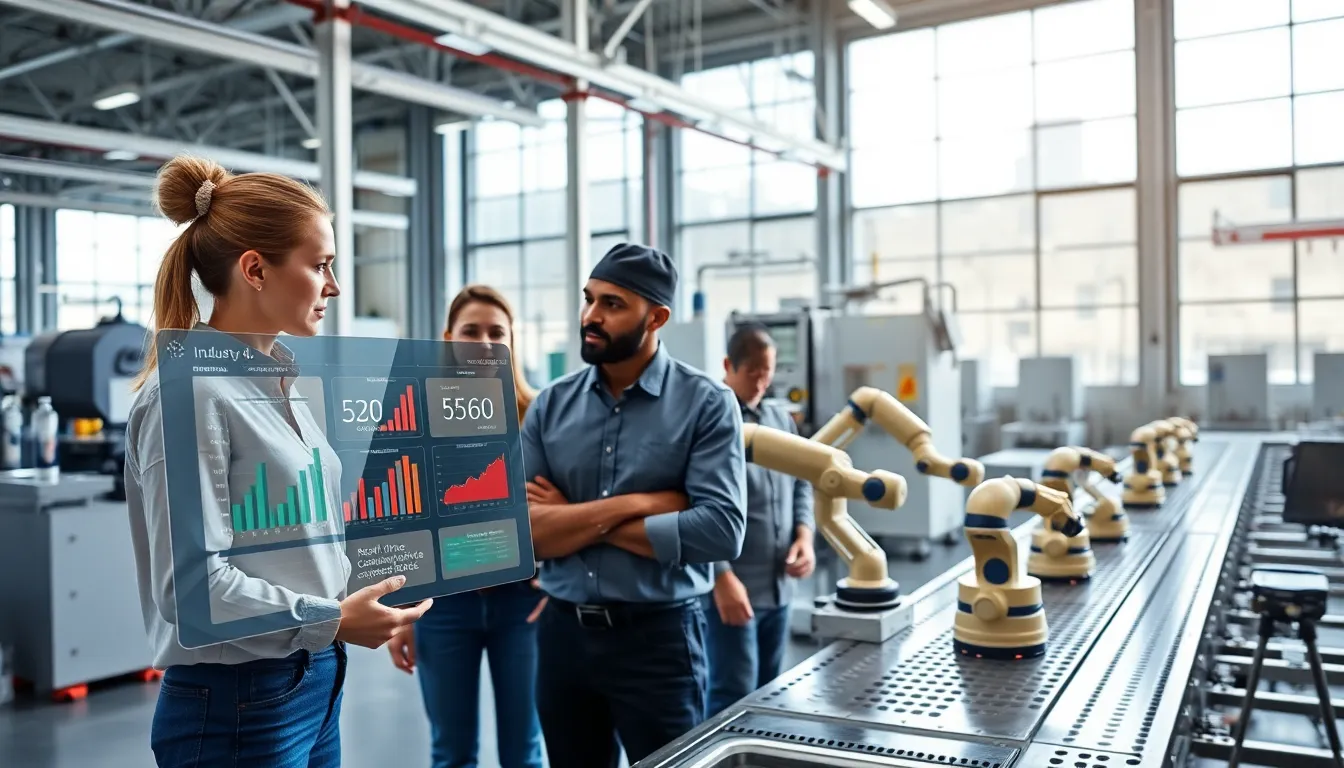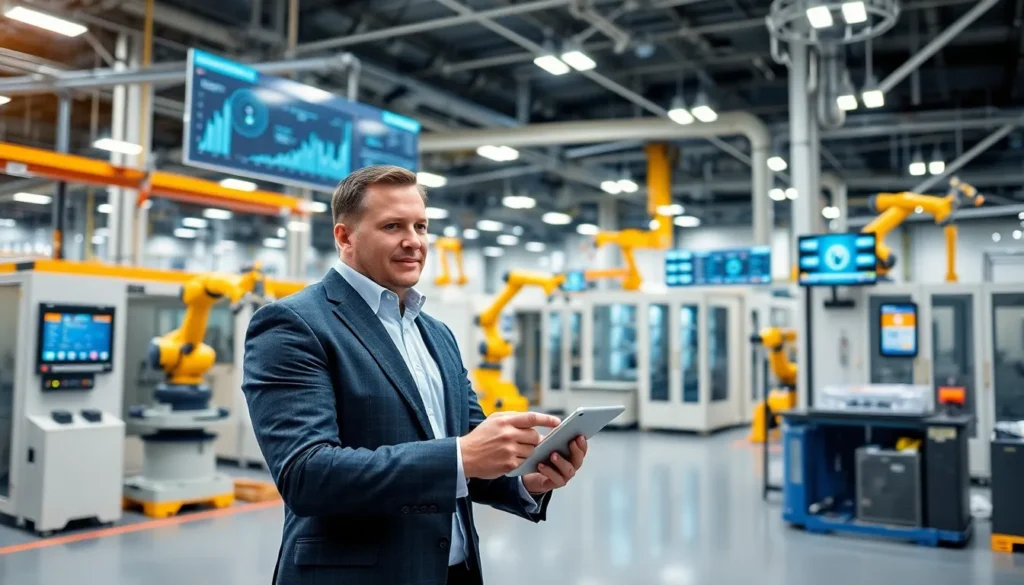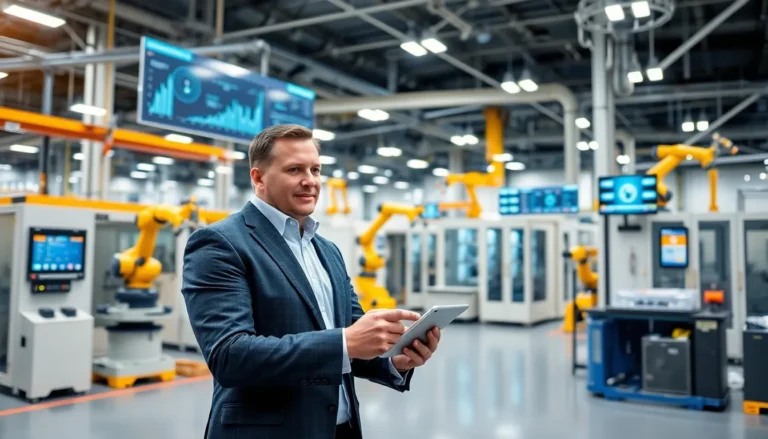Picture a factory floor bustling with machines that communicate with one another. What if this remarkable transformation wasn’t just a scene from a sci-fi movie? Welcome to Industry 4.0, the eccentric cousin of manufacturing revolutions. This new era is all about the Internet of Things (IoT) and its potential to revolutionize the way businesses operate. In an age where everything from toaster ovens to traffic lights is getting a digital upgrade, understanding Industry 4.0 and IoT is essential for staying ahead of the curve. So, buckle up as we jump into this exciting world of innovation.
Table of Contents
ToggleUnderstanding Industry 4.0

Industry 4.0 represents the fourth industrial revolution, characterized by the integration of digital technologies into manufacturing and production processes. Unlike its predecessors that brought mechanization, electrical power, and automation, Industry 4.0 enhances efficiency through cyber-physical systems. Think of it as a smart machine ecosystem where data flows seamlessly between machines, products, and people.
This transformation isn’t just about upgrading machinery. It’s about changing how businesses perceive and use data. With real-time analytics, predictive maintenance, and increased flexibility, operations can be streamlined for maximum efficiency. What does all this mean? Companies can respond to market demands faster than ever, reducing costs and increasing productivity.
The Role of the Internet of Things in Industry 4.0
In the grand scheme of Industry 4.0, the Internet of Things (IoT) plays a pivotal role. But what exactly is IoT? It’s a network of interconnected devices capable of collecting and sharing data over the internet. In an industrial context, these devices could be anything from sensors on a production line to advanced robotics.
IoT allows for real-time monitoring and control of machinery. For instance, consider a factory where machines are equipped with sensors that track their performance. When a machine begins to operate inefficiently, an alert can be triggered, prompting preventive measures before a costly breakdown occurs. This mitigates risks and optimizes operations through timely interventions.
Key Technologies Driving Industry 4.0
Several technologies are not just supporting but driving the momentum of Industry 4.0:
- Artificial Intelligence (AI): AI algorithms analyze vast datasets to enhance decision-making and automate processes.
- Big Data Analytics: Businesses leverage data to gain insights into operations and customer behavior.
- Cloud Computing: It enables scalable data storage and seamless sharing across vast networks, making it easier for companies to access all their operational data in one place.
- Cyber-Physical Systems: These integrate computations, networking, and physical processes, enabling machines to interact intelligently.
Imagine a scenario where a manufacturing plant can predict demand surges weeks ahead thanks to AI algorithms. This predictive capability enables operators to adjust production schedules proactively.
Benefits of Implementing Industry 4.0 Solutions
The benefits of embracing Industry 4.0 solutions are numerous and compelling:
- Increased Efficiency: Enhanced automation and predictive analytics lead to smoother operations.
- Cost Reduction: With optimized supply chains and reduced downtime, operational costs plummet.
- Flexibility: Businesses can adapt quickly to changes in consumer demand, offering personalized products without sacrificing production efficiency.
- Safety Improvements: Remote monitoring and smart devices can reduce workplace hazards by detecting potential issues before they escalate.
- Sustainability: By optimizing energy use and minimizing waste, Industry 4.0 promotes eco-friendly manufacturing practices.
Challenges in Adopting Industry 4.0 and IoT Technologies
Even though the advantages, companies face significant challenges when adopting Industry 4.0 technologies:
- High Initial Investment: Transitioning to smart manufacturing requires substantial upfront capital.
- Data Security Risks: As more devices connect online, vulnerabilities may increase, making cybersecurity a top priority.
- Skill Gaps: A workforce skilled in digital technologies is essential, yet many companies struggle to find qualified personnel.
- Integration Issues: Melding old systems with new technology can create compatibility issues, leading to further challenges.
Many companies find these hurdles daunting, yet proactive planning and investment in employee training can lead to successful integration.
Future Trends in Industry 4.0 and IoT
As Industry 4.0 continues to evolve, several trends are emerging:
- Edge Computing: This decentralizes data processing, allowing operations to be quicker and more efficient by processing data closer to where it is generated.
- 5G Technology: With faster data transmission speeds, 5G will enhance communications between IoT devices, making real-time data applications more practical.
- Autonomous Systems: Robotics and AI will play larger roles in automating not just manufacturing but logistics, maintenance, and customer service.
By observing these trends, businesses can position themselves as leaders rather than followers in this innovative era.










